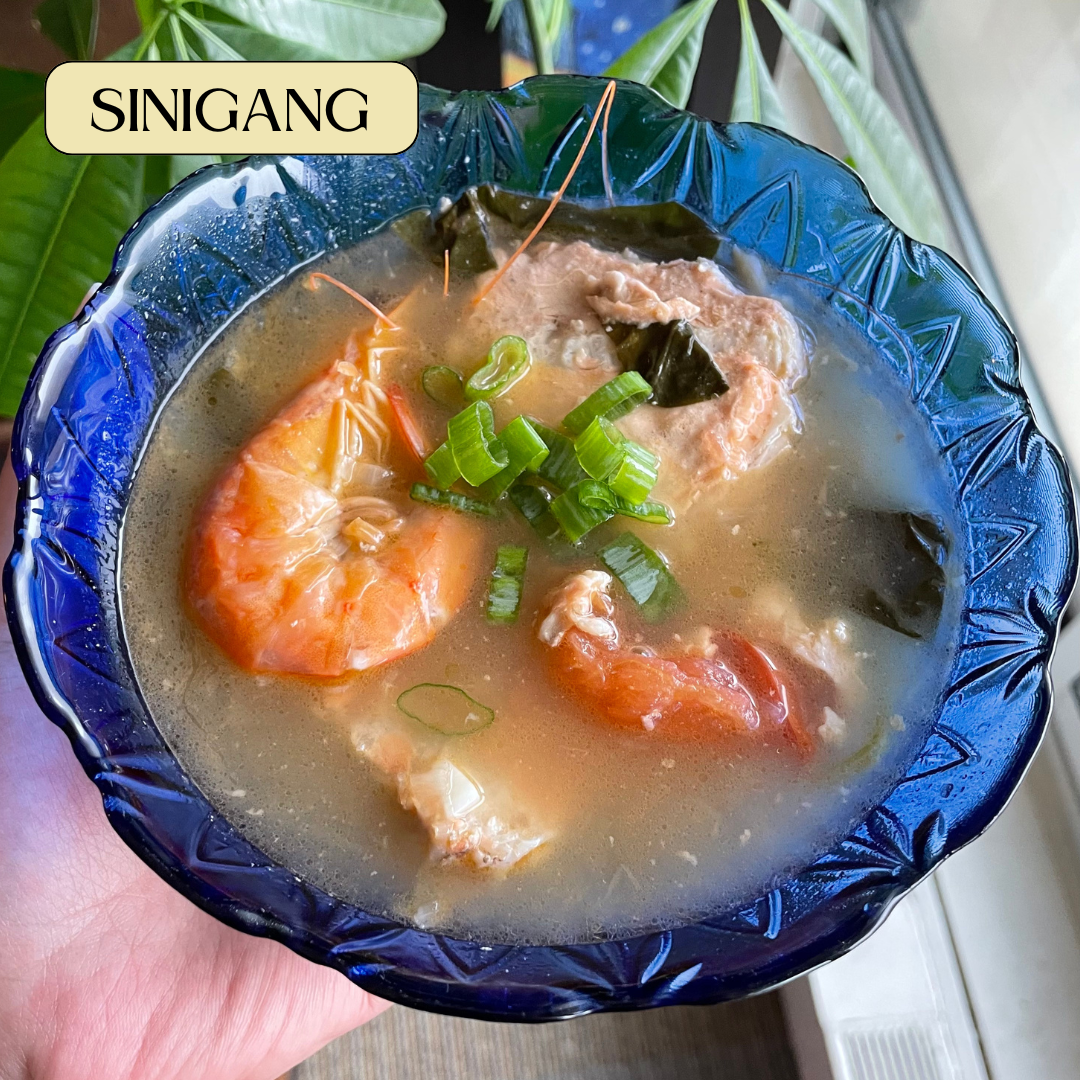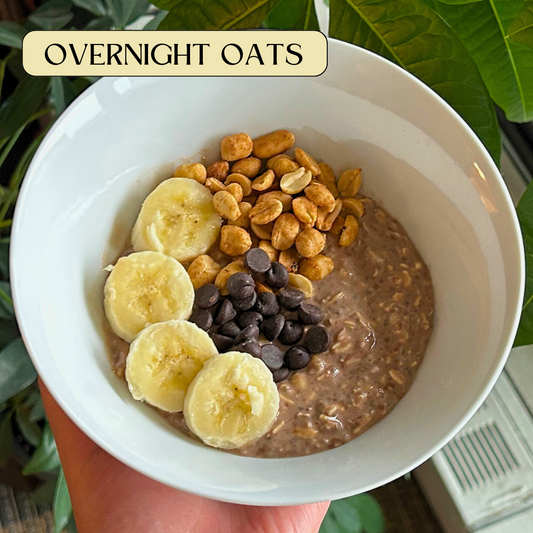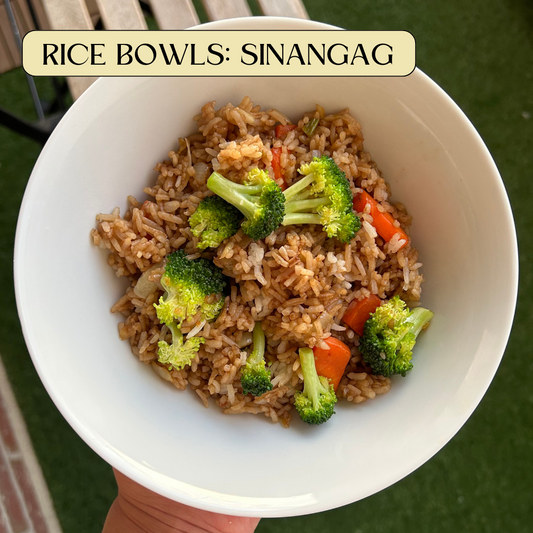| Table of Contents |
| What is Sinigang |
| Recipe for Salmon & Shrimp Sinigang |
| Recipe for Tofo Sinigang |
| Recipe for Pork Sinigang |
I'd be lying if I said I loved eating Sinigang as kid. To be honest, it wasn't my favourite and my mom usually made another dish alongside this. Luckily, I've come to appreciate this dish. One might say my taste has matured.
One day, after many years of not having sinigang for dinner, I just craved it. So, I called my mom and asked her what I needed to make it and how to make it.
I was pleasantly surprised to find out how easy it was to prepare. Sinigang has so much depth and complexity, I thought it was a soup that took hours to make, with many, many ingredients. On the contrary, sinigang is fairly quick to prepare and uses ingredients that are on-hand.
It is this dish, in particular, that brings me back home. It's nostalgic.
What is Sinigang?
Sinigang is a well-loved Filipino soup. It's tangy, savoury, very umami, and just warms your heart. Like many Filipino recipes, Sinigang can have many regional and household variations, but the flavour profile remains the same (more or less). It's a soup composed of veggies, protein, and a well-seasoned broth, but what makes it so unique is the distinct, lip-smacking, sour taste.
Sinigang is believed to have been a precolonial recipe, made from local ingredients. There isn't a direct English translation for the word Sinigang, although the name is commonly associated with the tartiness of the soup.

The Different Variations and Types of Sinigang
Because Sinigang is made with local ingredients, you're able to find many regional and household variations. The various souring agents, proteins and vegetables all contribute to the flavour profile of the soup.
How these variations may differ:
- The Souring Agent: The distinct sourness of the soup generally comes from tamarind, but calamansi (a Filipino lime/lemon), green mango, kamias fruit (a sour fruit found throughout Southeast Asia), and other sour fruits are can also be used as a souring agent. The different souring agents may slightly change the flavour profile of the soup. For instance, because it has a high concentration of tartaric acid, young tamarind is tangy and sweet, resulting in a tangy and sweet sinigang; on the other hand, the kamias is fairly acidic in nature, resulting in a sour and slightly bitter fruit (especially when they're unripe), so you'd get a sour and slightly bitter sinigang. The use of different souring agents stems from what fruits are available at the time.
- Protein: There are a number of proteins that could be added to sinigang - like pork, seafood, tofu, etc - so the preparations may also vary depending on the protein. Some proteins, such as pork, take longer to prepare, whereas proteins such as seafood and tofu cook fairly fast.
- Vegetables: Like the souring agent, the various vegetables used in a sinigang vary on what's available. Water spinach, eggplant, daikon radish, taro, and okra are pretty common ingredients. And although they're not native to the Philippines, tomatoes are also widely used in sinigang.

Although the different variations are attributed to the various ingredients that can be used in the soup, the general method and use of common seasonings make it so the taste of sinigang is still distinct from other soups.
Recipe for Sinigang
The flavours are complex, but the dish itself is quite easy to make. Especially with my mom's recipe. In true fashion, the sinigang dish my mom taught me uses ingredients that are available to me, as someone who lives in Toronto. For instance, I don't have access to fresh, young tamarind, but there is a Tamarind/Sinigang Soup Mix I can easily buy at my neighbourhood grocery store. Powdered Tamarind and/or Sinigang Soup mix are very convenient alternatives to fresh souring agents - they're usually a concentrate of tamarind, citric acid, msg, sugar, and salt, so their flavour is also very concentrated compared to fresh tamarind. Although, I'd opt for the Sinigang Soup mix over the Tamarind Soup mix for more flavour; the Sinigang Soup Mix usually includes more spices.
My favourite siningang soup mix is the Knorr Sinigang sa Sampalok Original, which I've seen in most grocery stores in my area. They even have sinigang soup mix especially for fish, one with miso, and one with taro. Mama Sita’s Sinigang sa Sampalok Mix is also a common Sinigang Soup Mix. However, if you're unable to find sinigang soup mixes, or if you prefer to season everything yourself, go for a tamarind soup mix or a tamarind powder. And if you have the time and access, feel free to use one of the aforementioned fresh fruits as your sinigang's souring agent, as opposed to the tamarind/sinigang soup mixes.
Measurements are approximate according to taste, feel free to add more or less veggies, seasoning, and/or protein, based on your preference.
I'll be going through 3 different types of recipes to accommodate different types of proteins:
One of the best things about this dish is the fact that you can make it all in one pot!
Recipe for Salmon & Shrimp Sinigang
Salmon and Shrimp Sinigang is my fav. Stewing in the broth, the fish gets so tender that it falls off the bone. Everything cooks fairly fast because seafood usually cooks fairly fast. And because the protein in this dish cooks fast, I'd use veggies that can be cooked quickly so nothing gets overdone.
Feel free to use another fish besides salmon, I like using salmon because it's a fatty fish and holds up pretty well when it simmers in a soup. Milkfish, tilapia, and pompano are other types of fish I've had in sinigang.
Recipe makes 2-3 servings and takes a little under an hour to prepare.

Ingredients
- About 1 tablespoon of Knorr Sinigang sa Sampalok Original or Knorr Sinigang na Isda (which is made especially for a fish sinigang)
- This may vary depending on taste preference/how sour you want your soup. Start with 1 tablespoon, taste your soup, then feel free to add a teaspoon of the mix at a time
- About 1 pound of salmon (you can use salmon fillet but the best salmon parts you can use for sinigang is the head and the trim. These cuts are fairly inexpensive compared to the fillet)
- About 150g of whole shrimp (use shrimp with the head and shell still on - that's where all the flavour is!)
- About an inch of ginger, thinly sliced
- ½ an onion, chopped
- 1 tomato, chopped
- Your fav veggies
- Because the fish and shrimp cooks fast, I recommend using veggies that cook fast
- With this sinigang, I like to add in spinach, okra, bok choy, and thinly sliced daikon radishes for some crunch!
- Fish sauce, to taste
- Black pepper, to taste
- Green onions/chives to garnish (optional)

Directions
- On medium heat, bring a litre of water in a pot to boil.
- As you wait for your water to boil, clean and prep your salmon, shrimp and veggies.
- Once the water starts to boil, toss in your chopped onions, tomatoes, and ginger.
- After about 5 minutes, or when the tomatoes and onions are tender, add in the salmon and shrimp.
- Let simmer for another 5 minutes before adding in a tablespoon of the sinigang soup mix and about 1-2 tablespoons of fish sauce. Stir thoroughly.
- Sprinkle in some ground black pepper and let sit for another 10-15 mins.
- When your salmon is cooked (you can tell when the meat can easily be removed from the bones), add in your vegetables and stir. If you're adding in spinach, add it in last.
- Lower the heat of your stove and let everything cook together for another 10 minutes.
- Taste your soup and add in more sinigang soup mix or fish sauce as needed. The more sinigang soup mix you add, the more tart/sour your soup becomes; the more fish sauce you add, the more salty and pungent your soup becomes.
- Once the soup is to your liking, transfer it into a bowl, garnish with green onions, and serve 🍲
Tofu Sinigang
Tofu Sinigang is another favourite of mine and cooks faster than the Salmon and Shrimp Sinigang. However, because tofu isn't much for taste, the broth may not be as complex as the seafood or pork recipes. That being said, I usually add in more sinigang soup mix and fish sauce to compensate.

Now, just because this is a vegetable soup with tofu, doesn't mean this dish is vegan or vegetarian. Fish sauce is an important ingredient in sinigang because it balances out the sourness and adds umami. To make this dish vegan/vegetarian, substitute the fish sauce with vegan fish sauce, and use tamarind paste/powder instead of the sinigang soup mix (I find that a lot of the sinigang soup mixes contain fish/shrimp).
Recipe makes 2-3 servings and takes about half an hour to prepare.
Ingredients
- About 1½ tablespoons of Knorr Sinigang sa Sampalok Original
- This may vary depending on taste preference/how sour you want your soup. Start with 1 tablespoon, taste your soup, then feel free to add a teaspoon of the mix at a time
- If you want this soup to be vegan/vegetarian, use tamarind paste or powder. Knorr doesn't seem to have any sinigang mixes without shrimp.
- About 150g of firm tofu, sliced into desired cuts
- About an inch of ginger, thinly sliced
- ½ an onion, chopped
- 1 tomato, chopped
- Your fav veggies
- With this sinigang, I like to add in eggplant, spinach, okra, bok choy, and thinly sliced daikon radishes for some crunch!
- Fish sauce, to taste
- If you want this soup to be vegan/vegetarian, use vegan fish sauce
- Soy sauce and seaweed are common fish sauce alternatives, but it wouldn't taste the same — still good though
- Black pepper, to taste
- Green onions/chives to garnish (optional)

Directions
- On medium heat, bring a litre of water in a pot to boil.
- As you wait for your water to boil, clean and prep your tofu and veggies.
- Once the water starts to boil, toss in your chopped onions, tomatoes, and ginger. If you're using vegetables that take longer to cook, like eggplant, I'd toss them in now as well.
- After about 5 minutes, or when the tomatoes and onions are tender, add in the tofu.
- Let simmer for another 5 minutes before adding in the sinigang soup mix, about 1-2 tablespoons of fish sauce, and ground black pepper. Stir thoroughly.
- When your tofu is cooked, add in your vegetables and stir. If you're adding in spinach, add it in last.
- Lower the heat of your stove and let everything cook together for another 5-10 minutes.
- Taste your soup and add in more sinigang soup mix or fish sauce as needed. The more sinigang soup mix you add, the more tart/sour your soup becomes; the more fish sauce you add, the more salty and pungent your soup becomes.
- Once the soup is to your liking, transfer it into a bowl, garnish with green onions, and serve 🍲
Pork Sinigang
The directions to this sinigang slightly differs from the aforementioned recipes. It requires more cook time since pork takes longer to cook than the seafood or tofu. Because pork takes longer to cook, my mom likes to use the pressure cooker when making this sinigang. Unfortunately, I do not have a pressure cooker and don't mind the dish's cook time, but if you have one laying around, feel free to use it to cut your cook time in half. Like the Salmon and Shrimp sinigang, the protein from this dish seeps into the broth and adds an additional depth of flavour. This dish tends to be a lot more savoury than the salmon & shrimp sinigang and the tofu sinigang, making the tartness of the soup more toned down.
Recipe makes 2-3 servings and takes a lil over an hour to prepare.
Ingredients
- About 1½ tablespoons of Knorr Sinigang sa Sampalok Original
- This may vary depending on taste preference/how sour you want your soup. Start with 1 tablespoon, taste your soup, then feel free to add a teaspoon of the mix at a time
- About 1lb of pork belly or 1½ lbs of baby pork back ribs
- The pork cut depends on preference. If you want a richer and savoury soup, opt for the pork belly
- If you're using pork belly, I recommend slicing the pork into 1½ inch cubes so it cooks evenly and fast
- About an inch of ginger, thinly sliced
- 3 cloves of garlic, chopped
- Feel free to use more garlic. Unlike most Filipino dishes, sinigang doesn't usually have garlic, but garlic goes very well with pork.
- ½ an onion, chopped
- 1 tomato, chopped
- Your fav veggies
- With this sinigang, I like to add in eggplant, spinach, okra, and bok choy
- Fish sauce, to taste
- Black pepper, to taste
- Green onions/chives to garnish (optional)

Directions
- Heat up a well-oiled pot on medium-high
- As your pot heats up, prepare you pork and veggies
- When your pot is nice and hot, add in your pork
- Sear the pork until crispy and cook the same on all sides. This may take at least 10 minutes, depending on the thickness and cut of your pork.
- Once your pork is cooked, remove from the pot and set aside
- In the same pot, quickly sauté your ginger, garlic, onions and tomatoes.
- Once fragrant, add your pork back into the pot, stir and let cook for a couple of minutes before adding about 1½ litres of water
- Wait for the water to boil before adding in the sinigang soup mix, about 2 tablespoons of fish sauce, and ground pepper. If you're adding veggies that take longer to cook, such as eggplant, add them in as well.
- Stir thoroughly and let sit for 10 mins.
- Taste your soup and add more sinigang soup mix, fish sauce, and ground pepper as needed. The more sinigang soup mix you add, the more tart/sour your soup becomes; the more fish sauce you add, the more salty and pungent your soup becomes.
- Add in the rest of your veggies before putting the heat on low and let simmer for another 5 minutes. Vegetables like spinach and bok choy cook fairly fast and I enjoy their texture more when they're cooked with a quick steam. If you prefer your veggies more tender, let everything simmer until the last of your veggies are cooked to your liking.
- Taste and season you soup again as needed. Once the soup is to your liking, transfer it into a bowl, garnish with green onions, and serve 🍲

Sinigang is normally served with rice, and can be enjoyed on it's own or as a side to your meal. It also tastes great the next day since everything just sits longer in the broth, so feel free to double your batch to enjoy this soup for the rest of the week!





